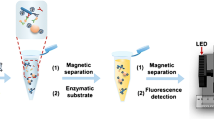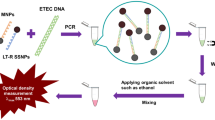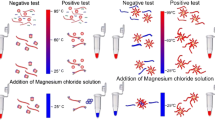Abstract
Magnetic nanoparticles and surface-enhanced Raman scattering (SERS) active nanoparticles were coated with short chain DNA tags. These were then used to identify a target bacterial DNA sequence. The tags function as primers in a standard PCR with the reverse primers and forward primers on the SERS nanoparticles and magnetic nanoparticles, respectively. During the PCR cycles, a composite nanostructure is formed that is both magnetically responsive and SERS active. After magnetic trapping, the intensity of the SERS signal can be related back to the concentration of the target DNA. A test assay was performed that showed a detection limit (based on the signal to noise ratio) of less than 3 zeptomole (41 pg/L). For comparison, a PCR assay based on the standard SYBR Green method was performed. This used the same primers and target DNA and had a detection limit of 10 attomoles (138 ng/L), 3,000 times less sensitive. The work documents the proof of principle study and shows for the first time the use of SERS-NP labels in the quantification of nucleic acid amplification tests and PCR.




Similar content being viewed by others
References
Alivisatos AP, Johnsson KP, Peng X, Wilson TE, Loweth CJ, Bruchez MP, Schultz PG (1996) Organization of ‘nanocrystal molecules’ using DNA. Nature 382:609–611
Barker AJ, Cage B, Russek S, Stoldt CR (2005) Ripening during magnetite nanoparticle synthesis: resulting interfacial defects and magnetic properties. J Appl Phys 98:063528
Bustin SA (2010) Developments in real-time PCR research and molecular diagnostics. Rev Mol Diagn 10:713–715
Chen W, Bian A, Agarwal A, Liu L, Shen H, Wang L, Xu C, Kotov NA (2009) Nanoparticle superstructures made by polymerase chain reaction: collective interactions of nanoparticles and a new principle for chiral materials. Nano Lett 9:2153–2159
Deng Z, Tian Y, Lee SH, Ribbe AE, Mao C (2005) DNA-encoded self-assembly of gold nanoparticles into one-dimensional arrays. Angew Chem Int Ed 44:3582–3585
Drake P, Cho HJ, Shih PS, Kao CH, Lee KF, Kuo CH, Lin XZ, Lin YJ (2007) Gd-doped iron-oxide nanoparticles for tumour therapy via magnetic field hyperthermia. J Matter Chem 17:4914–4918
Drake P, Chang HW, Lin YJ (2010) The design of a peptide linker group to enhance the SERS signal intensity of an atto680 dye-nanoparticle system. J Raman Spectrosc 41:1248–1253
Drake P, Jiang PS, Chang HW, Su SC, Tanha J, Tay LL, Chen P, Lin YJ (2013) Raman based detection of Staphylococcus aureus utilizing single domain antibody coated nanoparticle labels and magnetic trapping. Anal Methods 5:4152–4158
Driskell JD, Kwarta KM, Lipert RJ, Porter MD (2005) Low-level detection of viral pathogens by a surface-enhanced Raman scattering based immunoassay. Anal Chem 77:6147–6154
Elbaz J, Cecconello A, Fan Z, Govorov AO, Willner I (2013) Powering the programmed nanostructure and function of gold nanoparticles with catenated DNA machines. Nat Commun 4:2000
Enlow PD, Buncick M, Warmack RJ, Vo-Dinh T (1986) Detection of nitro polynuclear aromatic compounds by surface-enhanced Raman spectrometry. Anal Chem 58:1119–1123
Faulds K, Smith WE, Graham D (2005) DNA detection by surface enhanced resonance Raman scattering (SERRS). Analyst 130:1125–1131
Grubisha DS, Lipert RJ, Park HY, Driskell J, Porter MD (2003) Femtomolar detection of prostate-specific antigen: an immunoassay based on surface-enhanced Raman scattering and immunogold labels. Anal Chem 75:5936–5943
He N, Li S, Liu H (2009) High-throughput SNP detection based on PCR amplification on magnetic nanoparticles using dual-color hybridization. Methods Mol Biol 578:393–402
Hibbitts S, White PL, Green J, McNay G, Graham D, Stevenson R (2014) Human papilloma virus genotyping by surface-enhanced Raman scattering. Anal Methods 6:1288–1290
Higashi T, Nagaoka Y, Minegishi H, Echigo A, Usami R, Maekawa T, Hanajiri T (2011) Regulation of PCR efficiency with magnetic nanoparticles in a rotating magnetic field. Chem Phys Lett 506:239–242
Huang J, Zhang X, Wang C, Wang L, Li H, Cao X, Zhang A, Li X, Fan C, Hu J (2008) Size and surface effects of gold nanoparticles in nanogold assisted PCR. Surf Rev Lett 15:757–762
Li M, Lin YC, Wu CC, Liu HS (2005a) Enhancing the efficiency of a PCR using gold nanoparticles. Nucleic Acids Res 33:e184
Li H, Huang J, Lv J, An H, Zhang X, Zhang Z, Fan C, Hu J (2005b) Nanoparticle PCR: nanogold assisted PCR with enhanced specificity. Angew Chem Int Ed 44(32):5100–5103
Li Z, He L, He N, Deng Y, Shi Z, Wang H, Li S, Liu H, Wang Z, Wang D (2011) Polymerase chain reaction coupling with magnetic nanoparticles-based biotin–avidin system for amplification of chemiluminescent detection signals of nucleic acid. J Nanosci Nanotechnol 11:1074–1078
Loweth CJ, Caldwell WB, Peng X, Alivisatos AP, Schultz PG (1999) DNA-based assembly of gold nanocrystals. Angew Chem Int Ed 38:1808–1812
Maurin M (2012) Real-time PCR as a diagnostic tool for bacterial diseases. Rev Mol Diagn 12:731–754
Michota A, Bukowska J (2003) Surface-enhanced Raman scattering (SERS) of 4-mercaptobenzoic acid on silver and gold substrates. J Raman Spectrosc 34:21–25
Nicewarner Pena SR, Raina S, Goodrich GP, Fedoroff NV, Keating CD (2002) Hybridization and enzymatic extension of Au nanoparticle-bound oligonucleotides. J Am Chem Soc 124:7314–7323
Strelau KK, Brinker A, Schnee C, Weber K, Moller R, Popp J (2011) Detection of PCR products amplified from DNA of epizootic pathogens using magnetic nanoparticles and SERS. J Raman Spectrosc 42:243–250
Su X, Zhang J, Sun L, Koo TW, Chan S, Sundararajan N, Yamakawa M, Berlin AA (2005) Composite organic–inorganic nanoparticles (COINs) with chemically encoded optical signatures. Nano Lett 5:49–54
Tokareva I, Hutter E (2004) Hybridization of oligonucleotide-modified silver and gold nanoparticles in aqueous dispersions and on gold films. J Am Chem Soc 126:15784–15789
Vu BV, Litvinov D, Willson RC (2008) Gold nanoparticle effects in polymerase chain reaction: favoring of smaller products by polymerase adsorption. Anal Chem 80:5462–5467
Wan W, Yeow JTW (2009) The effects of gold nanoparticles with different sizes on polymerase chain reaction efficiency. Nanotechnology 20:325702
Xu S, Ji X, Xu W, Li X, Wang L, Bai Y, Zhao B, Ozaki Y (2004) Immunoassay using probe-labelling immunogold nanoparticles with silver staining enhancement via surface-enhanced Raman scattering. Analyst 129:63–68
Xu S, Ji X, Xu W, Zhao B, Dou X, Bai Y, Ozaki Y (2005) Surface-enhanced Raman scattering studies on immunoassay. J Biomed Opt 10(031112):1–12
Yang W, Mi L, Cao X, Zhang X, Fan C, Hu J (2008) Evaluation of gold nanoparticles as the additive in real-time polymerase chain reaction with SYBR green I dye. Nanotechnology 19:255101
Zhang Y, Guo Y, Quirke P, Zhou D (2013a) Ultrasensitive single-nucleotide polymorphism detection using target-recycled ligation, strand displacement and enzymatic amplification. Nanoscale 5:5027–5035
Zhang Y, Lu F, Yager KG, van der Lelie D, Gang O (2013b) A general strategy for the DNA-mediated self-assembly of functional nanoparticles into heterogeneous systems. Nat Nanotechnol 8:865–872
Zhao Y, Xu L, Kuang H, Wang L, Xu C (2012) Asymmetric and symmetric PCR of gold nanoparticles: a pathway to scaled-up self-assembly with tunable chirality. J Mater Chem 22:5574–5580
Author information
Authors and Affiliations
Corresponding author
Electronic supplementary material
Below is the link to the electronic supplementary material.
Rights and permissions
About this article
Cite this article
Drake, P., Chen, YC., Lehmann, I. et al. Nanoparticle labels for pathogen detection through nucleic acid amplification tests. Microfluid Nanofluid 19, 299–305 (2015). https://doi.org/10.1007/s10404-014-1530-8
Received:
Accepted:
Published:
Issue Date:
DOI: https://doi.org/10.1007/s10404-014-1530-8




